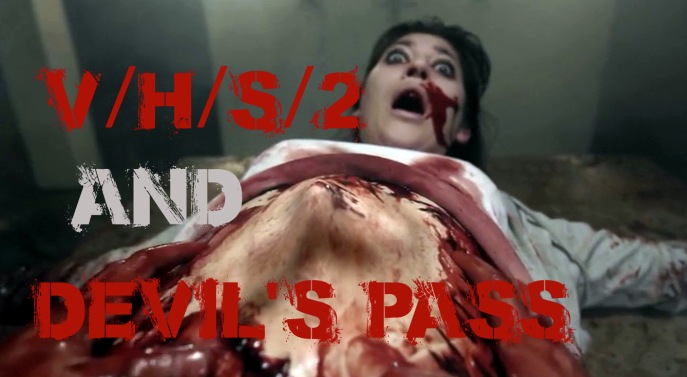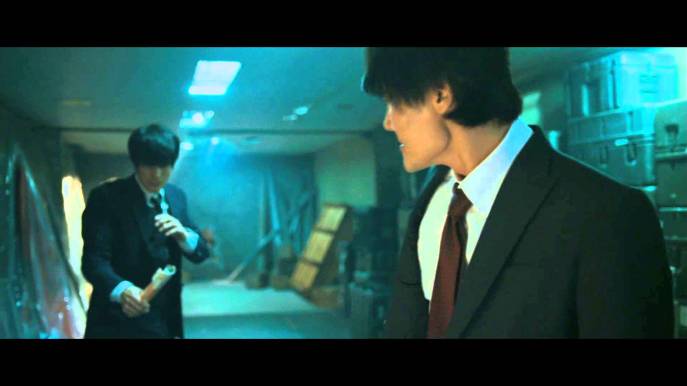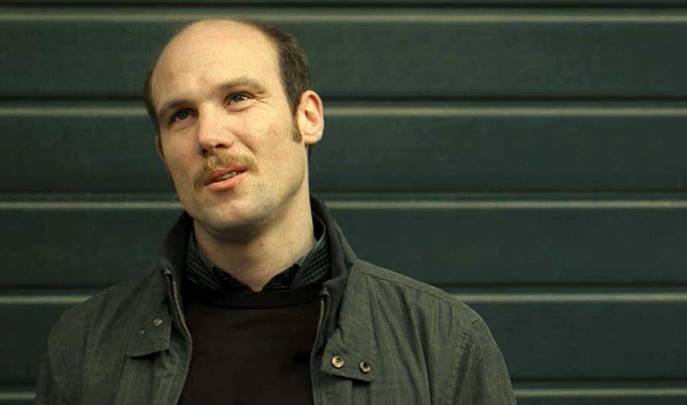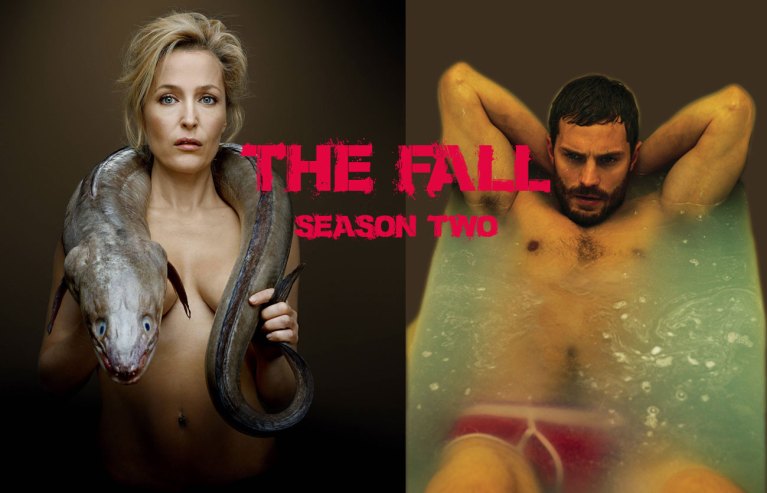It’s that time of the year again—a time when Mother Nature sheds her stillborn august growth and icy rains rattle windows in the coal-black night. Swirling winds snake about the skeletal limbs of decaying trees and crunchy auburn leaves turn to pulpy slop underfoot. Mist steals from the quivering forest bracken like an army of tattered ghouls, seeking predatory respite in the warmth of human flesh, and the forlorn laments of the howling departed cast a gray hell across the heavens.
Or perhaps living in Wisconsin and reading too much Cormac McCarthy has finally gotten to me.
The point is that the autumnal hour is nigh to binge on horror flicks (and depraved cinema in general), so I’ve scoured the bowels of Netflix’s streaming catalogue to come up with a gnarly little menu of back-to-back features. Sure, some of them are bigger-name titles you’ve already seen, but if you’re having a horror-a-thon with some folks less acquainted with the genre, a film like Silence of the Lambs is a perfect thematic gateway to something a bit more foreign and bleak, like the Korean revenge-torture fest I Saw the Devil.
So just as you pair your imperial pumpkin ale with a hearty stew, pair these 22 flicks together for one hell of a ravenous All Hallows Eve binge.
Bloodsuckers and the Badasses Who Bludgeon Them
 When George Clooney starred alongside Quentin Tarantino and Harvey Keitel in Robert Rodriguez’s From Dusk Till Dawn (1996), he was nothing more than a hunky TV actor (having spent the three years prior in residence on Friends, Sisters and Bodies of Evidence). Then Seth Gecko came along and fucked shit up with a full-scale vamp massacre at the Titty Twister bar just south of the Texas border. You’ve all seen it, so no need to divulge further. But when TMC and AMC are revisting Halloween 1-7, why not queue up the best action vampire movie ever made? Oh yeah, and Salma Hayek as Santánico Pandemónium… Nuff said.
When George Clooney starred alongside Quentin Tarantino and Harvey Keitel in Robert Rodriguez’s From Dusk Till Dawn (1996), he was nothing more than a hunky TV actor (having spent the three years prior in residence on Friends, Sisters and Bodies of Evidence). Then Seth Gecko came along and fucked shit up with a full-scale vamp massacre at the Titty Twister bar just south of the Texas border. You’ve all seen it, so no need to divulge further. But when TMC and AMC are revisting Halloween 1-7, why not queue up the best action vampire movie ever made? Oh yeah, and Salma Hayek as Santánico Pandemónium… Nuff said.
As an encore, Stake Land is a killer treat for any of your movie-night friends who aren’t as well-versed in indie horror. The great Jim Mickle’s vampire road story plays out like a longer and more fully realized Walking Dead episode. That parallel should make it extremely accessible for any viewer with even the faintest interest in horror, and Nick Damici is just one mean muthafuckin’ vamp slayer. (See him also on Netflix in the werewolf tale Late Phases—not as good as Stake Land, but totally worthwhile.)
Stake Land
IMDb: 6.5
GRADE: A-
From Dusk Till Dawn
IMDb: 7.3
GRADE: A / A-
Candid Camera Carnage
 I think it’s fair to say at this point that “found footage” has undergone a renaissance over the past several years, moving it from schticky, attention-grabbing, Blair Witch piggybacker to a subgenre with considerable merit and at least a few more avenues to explore. A prime example of this is the “Safe Haven” segment in V/H/S/2, arguably the best 40 minutes of “found footage” ever shot. V/H/S/2‘s other four shorts also hold up admirably, and the visual upgrade to HD from the original V/H/S’ shoddy handheld format creates for a much more fully realized—and less nauseating—horror fest.
I think it’s fair to say at this point that “found footage” has undergone a renaissance over the past several years, moving it from schticky, attention-grabbing, Blair Witch piggybacker to a subgenre with considerable merit and at least a few more avenues to explore. A prime example of this is the “Safe Haven” segment in V/H/S/2, arguably the best 40 minutes of “found footage” ever shot. V/H/S/2‘s other four shorts also hold up admirably, and the visual upgrade to HD from the original V/H/S’ shoddy handheld format creates for a much more fully realized—and less nauseating—horror fest.
I had zero expectations for Devil’s Pass, a film about a documentary crew looking to unearth deathly secrets in Russia’s Ural Mountains. So I was surprisingly pleased with what amounted to essentially the poor-man’s found-footage version of The Descent. Sure, there have been better efforts in the subgenre recently (see: Contracted, Rec, Quarantine), but in terms of what Netflix has to offer, this is a nice diamond in the rough—replete with a healthy mix of gore, “jump scares” and ambitious CGI. (Side note: The Last Podcast on the Left covered the Dylatov Pass Incident rather hilariously, if ye ask me.)
V/H/S/2
IMDb: 6.1
GRADE: B+ / A-
Devil’s Pass
IMDb: 5.7
GRADE: B
Zombie Lockdown
 If it weren’t for George Romero, The Walking Dead—and cinematic zombie culture as we know it—would probably be operating out of some cutesy, Twilight-style Christian chastity parable, with Selena Gomez and Zac Efron chewing at one another’s undead lips.
If it weren’t for George Romero, The Walking Dead—and cinematic zombie culture as we know it—would probably be operating out of some cutesy, Twilight-style Christian chastity parable, with Selena Gomez and Zac Efron chewing at one another’s undead lips.
Thanks to Romero, we have unadulterated gore—and the prototype for the haggard, flesh-hungry walker that gave birth to iterations such as 28 Days Later’s rabid, running walker and Dead Snow‘s militaristic Nazi walkers. While Day of the Dead isn’t Romero’s masterpiece (unfortunately Night of the Living Dead and Dawn of the Dead aren’t on Netflix, nor is 2007’s much-slept-on Diary of the Dead), it showcases the type of zombie makeup and special effects that infected the entire genre to present day. Sure, the dialogue and acting can be a bit stilted, but when the gates bust loose and the zombie bunker turns into an all-out war zone, Day of the Dead is just as entertaining as its modern-day counterparts.
If you want more of a no-nonsense zombie thriller full of gore and action that’s less of a nostalgic history lesson, the 2009 French film The Horde hits all the right notes. As I wrote in my original post on The Horde, it’s “basically the perfect film for Walking Dead fans who enjoy that show for the zombie-body-count factor.” (Last Walking Dead comparison today, I promise.) The tale of two warring factions—French cops and French thugs—joining forces to plow down zombies in a high-rise is a simple backdrop for an insane amount of lecherously good carnage. This movie isn’t heady. But never is there a dull moment as the body count piles in ways that makes World War Z look yawn-inducing.
Day of the Dead
IMDb: 7.2
The Horde
IMDb: 5.9
GRADE: B
Serial Psychos
 Silence of the Lambs isn’t a horror movie, so why am I recommending it around Halloween, ye ask? For starters, it’s the most fucked up movie ever to win an Oscar for Best Picture (and at its time, arguably the best movie to win the award since The Deer Hunter 13 years prior). But more importantly, Anthony Hopkins’ iconic character of Hannibal Lecter (first introduced on celluloid via Brian Cox in Brian DePalma’s gloriously 1980s-as-fuck Manhunter) is one of the best portrayals of a homicidal psycopath in big-screen history (thus the avalanche of sequels). Further, watching Lecter in all his demonic genius for two hours sets the perfect stage for the chianti I’m pairing with these blood-red fava beans: South Korean director Jee-woon Kim’s I Saw the Devil.
Silence of the Lambs isn’t a horror movie, so why am I recommending it around Halloween, ye ask? For starters, it’s the most fucked up movie ever to win an Oscar for Best Picture (and at its time, arguably the best movie to win the award since The Deer Hunter 13 years prior). But more importantly, Anthony Hopkins’ iconic character of Hannibal Lecter (first introduced on celluloid via Brian Cox in Brian DePalma’s gloriously 1980s-as-fuck Manhunter) is one of the best portrayals of a homicidal psycopath in big-screen history (thus the avalanche of sequels). Further, watching Lecter in all his demonic genius for two hours sets the perfect stage for the chianti I’m pairing with these blood-red fava beans: South Korean director Jee-woon Kim’s I Saw the Devil.
In Devil, we meet Kyung-chul (played by Min-sik Choi of Oldboy fame). Choi, it should be noted, is basically the poster child for the bleak and magnificent South Korean torture-revenge thriller movement that includes such classics as Park Chan-Wook’s Vengeance Trilogy (all on Netflix), The Man from Nowhere (also on Netflix) and The Chaser. As the homicidal Kyung-chul torments—and is tormented by—a young cop to whom the mission is quite personal, Devil unfolds as one of the best dark thrillers from any land made in the past few decades. Psycopaths, cannnibalism and mesmerizing, blood-spattered cinematography—they’re all here. The nonstop madness of this film should also quell the complaints of those who “don’t do subtitles.”
Silence of the Lambs
IMDb: 8.6
GRADE: A
I Saw the Devil
IMDb: 7.8
GRADE: A- / A
Campy Carnage Camp
 If we’re going the campy, comedic route, options abound on Netflix. Both Dead Snow and Dead Snow 2: Red vs. Dead are damn fun genre flicks, with the former leaning a little more toward horror and the latter a little heavier on self-parody. Housebound and Grabbers are also totally worth a ride, but for a perfect concoction of gore and guffaws, I’m gonna start with Tucker and Dale vs. Evil and Zombeavers.
If we’re going the campy, comedic route, options abound on Netflix. Both Dead Snow and Dead Snow 2: Red vs. Dead are damn fun genre flicks, with the former leaning a little more toward horror and the latter a little heavier on self-parody. Housebound and Grabbers are also totally worth a ride, but for a perfect concoction of gore and guffaws, I’m gonna start with Tucker and Dale vs. Evil and Zombeavers.
Tucker and Dale is pretty much a cult classic at this point. Its tale of two amiable rednecks unwittingly engaging in war with some “dumb college kids” camping in the backwoods is akin to Deliverance and Evil Dead meeting Joe Dirt. I personally liked Tucker and Dale even better than Cabin in the Woods (another film that pokes fun at what happens when dumb college kids go camping), meaning its easily one of my favorite horror comedies of all-time.
As for Zombeavers (also about wilderness-vacationing college kids)… I mean, it’s a movie called fucking Zombeavers. And that’s about as seriously as you should take it. If you come looking for nothing more than redneck jokes, t & a, bad puppet gore and an overload of “beaver” puns, you won’t be let down. This is definitely a movie to watch with a big group of people. My advice: the more booze, the better.
Tucker and Dale vs. Evil
IMDb: 7.6
GRADE: A- / B+
Zombeavers
IMDb: 4.8
GRADE: B / B-
Slashers and Home Invaders
 You’re Next is arguably the coolest movie on this list. It’s got just about everyone in the Ti West crew: West, Joe Swanberg, Adam Wingard (directing), Simon Barrett, Amy Seimetz, Kate Lyn Sheil, etc. Basically, it’s a cast of creatives who could walk into a coffee shop in Paris in the 1920s and fit in like a black-and-white striped shirt. What I’m getting at is that while I used to despise these hipsters for their mumblecore pretention, West and his counterparts are actually at the forefront of making good, modern horror movies that pay stylish homage to the genre’s past. And You’re Next—A home invasion thriller about an Australian survivalist girl who meets her boyfriend’s parents at the dinner party from hell—is arguably the collective’s best piece of work. (The Sacrament, V/H/S/2 and The Guest are all awesome, all from these folks, and all on Netflix, by the way.)
You’re Next is arguably the coolest movie on this list. It’s got just about everyone in the Ti West crew: West, Joe Swanberg, Adam Wingard (directing), Simon Barrett, Amy Seimetz, Kate Lyn Sheil, etc. Basically, it’s a cast of creatives who could walk into a coffee shop in Paris in the 1920s and fit in like a black-and-white striped shirt. What I’m getting at is that while I used to despise these hipsters for their mumblecore pretention, West and his counterparts are actually at the forefront of making good, modern horror movies that pay stylish homage to the genre’s past. And You’re Next—A home invasion thriller about an Australian survivalist girl who meets her boyfriend’s parents at the dinner party from hell—is arguably the collective’s best piece of work. (The Sacrament, V/H/S/2 and The Guest are all awesome, all from these folks, and all on Netflix, by the way.)
While there are movies from the late, great Wes Craven I much prefer to Scream (namely The Last House on the Left, The Hills Have Eyes and The People Under the Stairs), Scream was his biggest commercial success, far outgrossing A Nightmare on Elm Street. It was also one of those things when I was in junior high where if you were the last kid in class who hadn’t seen Scream, someone was bound to shit in your gym shoes. The movie has obviously spawned a host of horrible parodies and lesser sequels, but at least from the vantage point of a ’90s kid, its a slasher OG, and well, I just can’t really think of any slasher movie on Netflix that pairs as nicely with You’re Next. (Heads up: Scream leaves Netflix streaming on 11/1/15.)
You’re Next
IMDb: 6.5
GRADE: B+ / A-
Scream
IMDb: 7.2
People Said His Brain Was Infected by Devils (Possessed)
 When I posted my rather comprehensive list of the horror movies to watch on Netflix if you’ve already watched all the best ones, I can say in hindsight that there was one glaring omission: The Canal. Redditors (props) pointed me toward this slow-burn Irish chiller about a film archivist dealing with paranormal home events, and it turned out to be one of the eeriest damn movies I’d seen all year. Like I said, slow, but probably one of the most genuinely frightening movies on this list.
When I posted my rather comprehensive list of the horror movies to watch on Netflix if you’ve already watched all the best ones, I can say in hindsight that there was one glaring omission: The Canal. Redditors (props) pointed me toward this slow-burn Irish chiller about a film archivist dealing with paranormal home events, and it turned out to be one of the eeriest damn movies I’d seen all year. Like I said, slow, but probably one of the most genuinely frightening movies on this list.
Also full of “jump scares” and a litany of mysterious chills, I was immensely impressed with the found-footage flick The Taking of Deborah Logan, about an Alzheimer’s patient who falls prey to demonic forces. Definitely in my top five as far as found footage goes, and also worth watching simply for one of the most awesome pieces of CGI imagery in any recent horror film.
The Canal
IMDb: 5.9
GRADE: B+
The Taking of Deborah Logan
IMDb: 6.5
GRADE: B+ / A-
Spawn of Satan
 If Roman Polanski and R. Kelly have one thing in common, it’s that… they make great art! (Pedo-what? I said “art”…. Art I said!) Rosemary’s Baby, Chinatown and Frantic were to thrilling and chilling cinema what, say, 12 Play, Double Up and Black Panties were to landscape of modern gangster R&B.
If Roman Polanski and R. Kelly have one thing in common, it’s that… they make great art! (Pedo-what? I said “art”…. Art I said!) Rosemary’s Baby, Chinatown and Frantic were to thrilling and chilling cinema what, say, 12 Play, Double Up and Black Panties were to landscape of modern gangster R&B.
In all seriousness, I’m throwing Rosemary’s Baby on here because a lot of people see it as one of the greatest horror films of all time, and I ain’t arguin’. Even nearly half a century and a few Swedish extraditions later, Polanski’s classic about the seeds sown by a demonic cult still measures up to the genre’s heavyweights.
As for Starry Eyes, I’m including it here mainly because Netflix just stripped us of House of the Devil (shame on you, Netflix). Still, if you’re in the mood for a little bit of Ol’ Beezlebub getting up your knickers, Starry Eyes is a grotesquely creepy flick about a would-be Hollywood starlet and her quest for fame. The parallel drawn between everyone in Hollywood being a fame whore and devil worship is perhaps a little heavy-handed, but give credit to Alex Essoe for one of the best horror performances this side of Essie Davis in Babadook. Put bluntly, this is some sick, twisted shit—and a pretty fun ride for those who can stomach it.
Rosemary’s Baby
IMDb: 8.0
Starry Eyes
IMDb: 6.0
GRADE: B / B-
Tastes Like Chicken (Cannibals)
 My favorite thing about Ravenous is the film’s fever-dream atmosphere, created in large part by Daniel Lindholm’s haunting melody that plays as a bloodied Guy Pearce trudges through the snowy Sierra Nevada wilderness. Part Jack London, part Cormac McCarthy and part Cannibal! the Musical, Ravenous’ admixture of existentialist pioneering, survivalist bloodbaths and tongue-in-cheek historical-fiction comedy create for an extremely fun, weird piece of cannibal folklore. And Guy Pearce (The Proposition, Memento), Robert Carlyle (Trainspotting), Neal McDonough (Band of Brothers) and Jeffrey Jones (The Pest) simply could not have been cast better.
My favorite thing about Ravenous is the film’s fever-dream atmosphere, created in large part by Daniel Lindholm’s haunting melody that plays as a bloodied Guy Pearce trudges through the snowy Sierra Nevada wilderness. Part Jack London, part Cormac McCarthy and part Cannibal! the Musical, Ravenous’ admixture of existentialist pioneering, survivalist bloodbaths and tongue-in-cheek historical-fiction comedy create for an extremely fun, weird piece of cannibal folklore. And Guy Pearce (The Proposition, Memento), Robert Carlyle (Trainspotting), Neal McDonough (Band of Brothers) and Jeffrey Jones (The Pest) simply could not have been cast better.
If you want to go back-to-back cannibal (coincidentally Jeffrey Dahmer’s favorite coital position) and all you have is Netflix, you’re gonna have to run with We Are What We Are. I say that somewhat disparagingly because yeah, it’s my least favorite movie on this list. The tale of flesh-eating hilljacks preserving an old way of life is as predictable as can be, but… But! It’s directed by the great Jim Mickle (Stake Land, Cold in July), who uses an atmosphere of permanent torrential downpour to tremendous cinematographic effect here. It’s also got side roles from Michael Parks (Tusk, Red State) and Nick Damici (Stake Land, Late Phases), which should pique the interests of any modern horror fan worth their salt.
Ravenous
IMDb: 7.1
GRADE: B+
We Are What We Are
IMDb: 5.8
GRADE: B- / C+
Party in the USA!
 Where so many attempt to carve a cult-classic novel with a maniacal protagonist into a a serviceable film, so few succeed. There are exceptions however, such as Terry Gilliam’s Fear and Loathing in Las Vegas and Milos Forman’s One Flew Over the Cuckoo’s Nest. There’s also Mary Harron’s brilliant adaptation of Bret Easton Ellis’ apathetically savage tale about vapid consumerism and narcissism. Like Fear and Loathing, American Psycho, the movie, can be watched and quoted ad infinitum without it ever growing tired. And Christian Bale simply embodies Ellis’ character of Patrick Bateman in one of the finest antihero performances of all time. (I’ll let the reader judge if Kevin Spacey really deserved that Oscar for American Beauty in 2000).
Where so many attempt to carve a cult-classic novel with a maniacal protagonist into a a serviceable film, so few succeed. There are exceptions however, such as Terry Gilliam’s Fear and Loathing in Las Vegas and Milos Forman’s One Flew Over the Cuckoo’s Nest. There’s also Mary Harron’s brilliant adaptation of Bret Easton Ellis’ apathetically savage tale about vapid consumerism and narcissism. Like Fear and Loathing, American Psycho, the movie, can be watched and quoted ad infinitum without it ever growing tired. And Christian Bale simply embodies Ellis’ character of Patrick Bateman in one of the finest antihero performances of all time. (I’ll let the reader judge if Kevin Spacey really deserved that Oscar for American Beauty in 2000).
 While reveling in an old favorite is always fun, if you’re a horror fan and haven’t seen American Mary, tripping you are. Katherine Isabelle’s role as a med student who turns to the blackmarket of body modification (all while taking out her vengeance on a seedy underworld of the upper-crust) is arguably the sexiest lead horror performance since… I’m gonna go with Eliza Dushku in Wrong Turn (great movie, by the way). Like American Psycho, Mary is also savagely and stylistically delightful, finding humor in the bleakest blood-spattered corners of our human fabric.
While reveling in an old favorite is always fun, if you’re a horror fan and haven’t seen American Mary, tripping you are. Katherine Isabelle’s role as a med student who turns to the blackmarket of body modification (all while taking out her vengeance on a seedy underworld of the upper-crust) is arguably the sexiest lead horror performance since… I’m gonna go with Eliza Dushku in Wrong Turn (great movie, by the way). Like American Psycho, Mary is also savagely and stylistically delightful, finding humor in the bleakest blood-spattered corners of our human fabric.
American Psycho
IMDb: 7.6
GRADE: A
American Mary
IMDb: 6.3
GRADE: B / B+
Creature Features
 I include Open Water on this list not because it’s horror, but because I’ve never been more genuinely terrified watching a movie on the big screen than I was when I saw this in theaters a decade ago. Through the guerilla lens of shooting at night in actual shark-infested Bahamian waters, director Chris Kentis creates serves up arguably the most viscerally infectious shark movie ever made. It’s not about big fins knifing a b-line through the water at unsuspecting maidens; Open Water‘s dread lies in nibbles on the feet, hazy outlines on an eye-level horizon of eternally foreign sea, and small splashes and flickering tails that all signal the most mindfuckingly awful death this side of what went down in George Sluizer’s 1988 Dutch thriller Spoorloos. This deserves a big screen, pitch black and utter silence.
I include Open Water on this list not because it’s horror, but because I’ve never been more genuinely terrified watching a movie on the big screen than I was when I saw this in theaters a decade ago. Through the guerilla lens of shooting at night in actual shark-infested Bahamian waters, director Chris Kentis creates serves up arguably the most viscerally infectious shark movie ever made. It’s not about big fins knifing a b-line through the water at unsuspecting maidens; Open Water‘s dread lies in nibbles on the feet, hazy outlines on an eye-level horizon of eternally foreign sea, and small splashes and flickering tails that all signal the most mindfuckingly awful death this side of what went down in George Sluizer’s 1988 Dutch thriller Spoorloos. This deserves a big screen, pitch black and utter silence.
Want more creature? The Host is another one I was lucky enough to catch on the big screen. I remember this vividly (despite being stoned out of my mind) simply because it had the best creature CGI I’d ever seen. As a mutant river monster wreaks havoc on Seoul, a family struggles with all the hallmarks of South Korean cinema—bitter anguish, bowel-churning pain and a quest for revenge. The story meanders a little toward the end, but it’s worth it for the creature effects alone (which hold up very nicely 15 years later, stoned or not).
Open Water
IMDb: 5.7
The Host
IMDb: 7.0
-Sam Adams
NOTE: I left several films ungraded simply because they weren’t fresh enough in my memory to be subject to such biased scrutiny.
NOTE 2: IMDb ratings for horror movies are criminally low. If it’s above a 6 and isn’t a critical darling (Babadook, A Girl Walks Home Alone at Night) or a blockbuster (Oculus), it will most likely be better than 90 percent of the movies nominated for an Oscar this year.
 Falling thematically somewhere between Infernal Affairs and Headhunters is director Seong-hoon Kim’s A Hard Day. The Infernal Affairs comparison comes from Hard Day being about a deadly game of cat-and-mouse involving crooked cops. The Headhunters one is mainly because Hard Day is the most nerve-wracking, tension-riddled thriller I’ve seen since that incredible piece of Norwegian cinema.
Falling thematically somewhere between Infernal Affairs and Headhunters is director Seong-hoon Kim’s A Hard Day. The Infernal Affairs comparison comes from Hard Day being about a deadly game of cat-and-mouse involving crooked cops. The Headhunters one is mainly because Hard Day is the most nerve-wracking, tension-riddled thriller I’ve seen since that incredible piece of Norwegian cinema. So about the title of this post: A main commonality between No Tears for the Dead and A Company Man is that they both follow world-weary assassins who are beginning to give in to a softer side when they’re roused out of bliss/apathy by a very personal offense. (It should be noted that this is a very common theme in “han” films.)
So about the title of this post: A main commonality between No Tears for the Dead and A Company Man is that they both follow world-weary assassins who are beginning to give in to a softer side when they’re roused out of bliss/apathy by a very personal offense. (It should be noted that this is a very common theme in “han” films.)





























































































